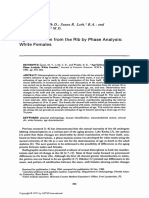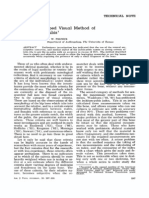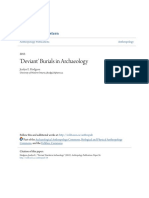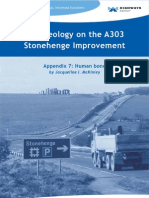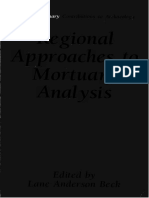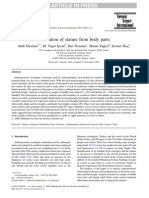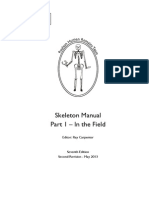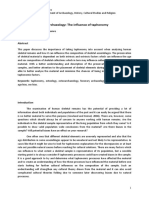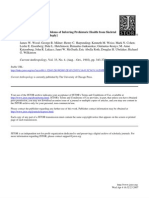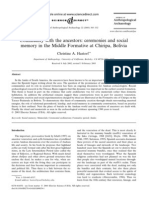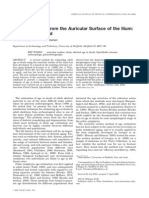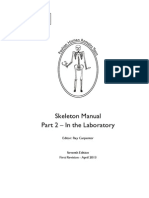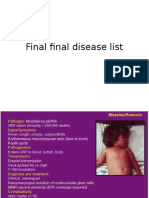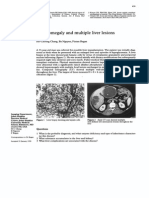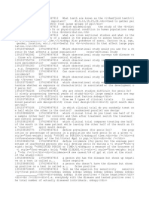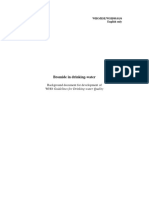Postmortem Skeletal Lesions
Postmortem Skeletal Lesions
Uploaded by
Jelena WehrCopyright:
Available Formats
Postmortem Skeletal Lesions
Postmortem Skeletal Lesions
Uploaded by
Jelena WehrOriginal Description:
Copyright
Available Formats
Share this document
Did you find this document useful?
Is this content inappropriate?
Copyright:
Available Formats
Postmortem Skeletal Lesions
Postmortem Skeletal Lesions
Uploaded by
Jelena WehrCopyright:
Available Formats
hensic
Science
ELSEVIER
Forensic Science International
89 (1997) 155-165
Interaatiml
Postmortem skeletal lesions
Gerald Quatrehommeab7*, Mehmet Yagar igcan
Department of Anthropology, Florida Atlantic University, Boca Raton, FL 33431, USA
bFaculte de M&deck de Nice, Laboratoire de Mkdecine tigale, 06107 Nice Cedex 5 France
Department of Anthropology, Florida Atluntic University, Boca Raton, FL 33431, USA
Received 26 March 1997; accepted 13 May I997
Abstract
Postmortem bone alterations are very frequent and can raise the issue of their nature
(antemortem, perimortem or postmortem defects). The aim of this work is to study various aspects
of defects which were not assessed as perimortem trauma, from a series of 50 defects examined,
resulting from 24 forensic cases. This study emphasizes the variability of size, shape and number
of postmortem defects. Usually the diagnosis of antemortem defects is helped by a careful
examination of some characteristics as the edges of the defects, the areas of discoloration of the
edges and of the whole bone. Elsewhere it appears very difficult to know the true nature
(antemortem, postmortem, or perimortem alterations) of the bone. 0 1997 Elsevier Science
Ireland Ltd.
Keywords: Skeletal lesions; Bone alterations; Bone defects
1. Introduction
Postmortem skeletal lesions are usually studied in the field of archaeology [l-5]. An
important issue is the differential diagnosis of perimortem trauma (for example, sharp
force injuries, gunshot wounds) and postmortem lesions, usually due to animal activity
[6-81, human activity [9] and environmental factors.
Some forensic anthropological cases are published, demonstrating the difficulty to
assess the different events, especially to assess if a bone trauma is of perimortem or
*Corresponding author. Address for correspondence: Faculte de MBdecine de Nice, Laboratoire de
MBdecine L&ale, 06107 Nice Cedex 2, France. Tel.: +33 4 92037763; fax: +33 4 92038148; e-mail:
gquatreh@hermes.unice.fr
0379-0738/97/$17.00 Q 1997 Elsevier Science Ireland Ltd. All rights reserved.
PII SO379-0738(97)001 13-8
156 G. Quatrehomme, M.Y. ipan I Forensic Science International 89 (1997) 155-165
postmortem nature [lo-141. Postmortem alterations of the bones may be due to
environmental factors (soil activity, weathering, mechanical erosion), and postmortem
trauma (animal or human activity). In certain cases the diagnosis may be very difficult
with an ante or perimortem trauma. The aim of this work is to study various aspects of
defects which were not assessed as perimortem trauma, from a series of forensic cases,
and to discuss the issue of the differential diagnosis between antemortem, perimortem,
and postmortem trauma in bones.
2. Materials and methods
Skeletal remains of victims of gunshot wounds were studied. In most cases the
circumstances of injury, scene and investigation reports, autopsy reports, demographic
data and photographs were available. Each defect was described (shape, location) and
measured. Special attention was focused on the description of the area surrounding the
defect, and the description of its edges, as well as associated features on the rest of the
bone. Antemortem medical history was also noted. A total of 50 defects from 24
forensic cases were examined.
3. Results
The location, shape, size, etiology of the lesions, as well as the total number of defects
in each case are summarized in Table 1. Single defects were found in 15 cases, and
multiple bone lesions in the others (two in six cases, three in one case, four in one case,
and 15 in one case).
Case Cl (Fig. 1A) and C2 (Fig. 1B and 1C) show thinning around the perimeter of
the edge, with the most pronounced thinning on the margins of the hole. Edges are
regular in both cases. There is a single defect in Cl (Fig. 1A) and multiple perforations
(four) in C2 (Fig. 1B and 1C). Note that the shape of the defects is highly variable, even
in the same case. In case C2, one is roughly oval or triangular, another semi-lunar (Fig.
lB), and a third in the shape of a club (Fig. 1C). The skull in case Cl (Fig. 1A) was
used for ceremonial activity. These two cases are thought to be the result of chemical
and mechanical erosion from the soi1. Erosion due to chemical in the soil will hereafter
be referred to as soil chemical erosion. Furthermore, in Cl, tooth marks support the
hypothesis of animal activity (Fig. 1A).
Case C3 (Fig. 1D) is an anatomical specimen or trophy skeleton. There are
holes seen in the right humeral head, and right and left mandibular rami. The edges of
the holes are very regular, the shape is perfectly round, and exactly match a drill. The
same observations were made in case C14, with the hole drilled in the sagittal suture.
In C4 there was a craniotomy two and a half years before death for a depressed
fracture. The craniotomy is large, oval and slightly irregular (Table 1). Another large
right paterial craniotomy with healing of the edges was observed in Cl 1. Cl2 (Fig. 1E)
also featured a large defect with healing of the edges (in the left occipital bone
impinging on the foramen magnum). Cl5 exhibits a roughly oval shaped defect with
G. Quatrehomme, M.Y. ip, 1 Forensic Science International 89 (1997) 155-165
157
Table 1
Location, shape, size and possible etiology of bone lesions
Case Location Shape Size
No. (cm)
Total Possible
N Etiology
Cl L. temporo-parietal Oval 2.5X1.5
c2 R. squamous temp. Clubs 2.0X 1.6
Left frontal
Left temporal
Oval, irreg.
Triangle,
irreg.
Semi-lunar
Round, reg.
Round, reg.
Round, reg.
Oval
Triangle
1 x0.5
1 X0.6
c3
c4
c5
Left temporal
R. humerus head
R. mand. ramus
L. mand. ramus
Left parietal
R. occ. fora. magn.
0.7x0.3
0.2
0.2
0.2
5x3
4.5x4.5x3
C6 L. lambdoid suture Oval 0.7x0.4
c7
L. occipital Nearly round 0.1
Occipital Very irreg. 5X2.5
Right mastoid Round 1.5
C8
c9
Cl0
Cl1
Cl2
Cl3
Cl4
Cl5
Cl6
Cl7
Cl8
Cl9
c20
c21
c22
C23
C24
Right frontal Semi-lunar 2.0
Right occiput Round 2.5
Left occiput Round 2.0
Left scapula Oval 1.6x1.1
R. parietal, vertex Oval 4.0x3.3
Right frontal Oval, irreg. 1.7X1.2
Occ (near for. magn.) Triangle 4.7x4.7x 1.7
Frontal Oval 0.9x0.7
Sagittal suture Round 0.8
Occ (near for. magn.) Oval 5x4
Occipital Oval 8.2X6.3
Left parietal Oval 0.5 X0.2
Occ (near for. magn.) Round 2.0
Right orbit Round 0.1
Left orbit Oval 2.0X 1 .o
R. frontal fossa Oval 0.7x0.5
R. frontal fossa Oval 0.6X0.4
Right parietal Round 0.8
Left maxilla Irregular 5X2
Nose Irregular 4.0x3.0
Two sides of skull Irregular 0.2 to 3.0
Greater trochanter Oval, irreg. 2.0X0.7
1
5
3
1
1
2
2
1
2
1
1
2
1
1
1
I
I
1
2
2
1
1
15
1
Animal,
mechanical,
and chemical
Chemical,
mechanical
Idem
Idem
Idem
Drill
Idem
Idem
Craniotomy
Chemical,
ceremonial
Chemical,
ceremonial
Idem
Chemical
Chemical,
mechanical
Chemical
Chemical
Idem
Chemical
Craniotomy
Craniotomy
Chemical
Blunt
Drill
Chemical
Chemical
Postmortem manipulation
Idem
Water
Idem
Chemical
Idem
Chemical
Unknown
Idem
Caustic
Old gunshot
wound with
158 G. Quatrehomme, M.Y. Ipan I Forensic Science International 89 (1997) 155- 165
Fig. 1. (A) shows large oval defect at left temporo-parietal junction (Cl) with tooth marks around periphery
(indicating animal activity). Effects of chemical and mechanical erosion are also involved. In Fig. C2 (B, C),
chemical and mechanical factors created defects of varied shapes including oval, triangular, and semi-lunar,
and clubs in the left frontal, the left temporal and the squamous region of right temporal. Perfectly round
hole is the result of drilling in the sagittal suture in (D) (C14) of an anatomical specimen or trophy skull.
(E) shows a large craniotomy with healing at the edge in right frontal bone (C12). Large, irregular occipital
defects with thinning of the edges may have a chemical and mechanical origin (C7).
white discoloration of the edges in the same location. In Cl6 there is a large, irregular,
roughly oval defect that encompasses the foramen magnum. A nearly round defect, 2 cm
in diameter is seen in Cl8 (a childs skull) caused by soil chemical erosion. This skull
was used for ceremonial activity. A defect also encroaching on the foramen magnum
was noted in C5. In this case the defect is roughly triangular, with thinning of the inner
table, in a skull that had been buried for many years. The base of the skull (used for
ceremonial activity) is missing and the edges are white, in contrast to the brown of the
rest of the skull.
In C6, the two defects are roughly oval. Soil is visible on inner and outer areas of the
skull, along with embedded roots. Many parts of the skull are missing (e.g the base and
part of the right vault). A slight defect is associated with the inner table of the left
parietal. This skull too was used for ceremonial activity.
In C7 (Fig. 1F) there is a large (5X2.5 cm) irregular occipital defect, an attenuated
paper-thin internal table and an abnormal separation of sutures. The comers of the defect
are rounded. There is white discoloration surrounding the lesion, along with erosion of
the occipital condyles and right mastoid process. There was a postmortem fracture of the
G. Quatrehomme, M.Y. i,wm I Forensic Science International 89 (1997) 155-165 159
left styloid process (whose edges were white in colour), and numerous perforations on
the skull. These lesions are considered postmortem defects formed by soil chemical and
mechanical erosion.
C8 has a semilunar defect, 2.0 cm in diameter, with no bevelling, attributed to
postmortem erosion from the soil. In C9 (Fig. 2A), the right occiput and the left occiput
display two roughly round defects with a white discoloration of the margins. Numerous
white discolorations in various forms (e.g., spots and roughly parallel lines) appear on
the cranial vault. The edges of the defect display thinning. Many parts of the bone are
missing, including the right orbit, right maxillary sinus and right zygomatic process. This
is a case of postmortem soil chemical and mechanical erosion.
Cl0 (Fig. 2B) has slightly irregular, oval defect in the left scapula that is attributed to
postmortem soil chemical erosion. Cl3 (Fig. 2C) features a regular oval, depressed
fracture that looks like a tangential gunshot wound, but there is no bevelling. Cl7 (Fig.
Fig. 2. (A) shows quasi-symmetrical large defects near the foramen magnum (C9) which may exemplify
chemical and mechanical erosion from the soil. In (B) there is a slight irregular, oval defect in the left scapula
(ClO) resulting from postmortem chemical exposure. (C) has an oval depressed fracture in the frontal bone
(C13) caused by blunt trauma. Regular oval defect (D) in left parietal of child skull used for ceremonial
activity. Wormian bone displaced, perhaps through mishandling. In (E) (C21) postmortem alteration
characterized by slightly irregular defect with thinning edges and coral-like appearance. Soil chemical erosion
led to formation of two oval defects in right frontal fossa (F, C20).
160 G. Quatrehomme, M.Y. igcan I Forensic Science International 89 (1997) 155-165
2D) is a child skull used for ceremonial activity. There is a regular oval defect in the left
parietal that was created when a wormian bone was displaced, perhaps through careless
handling.
Cl9 shows a tiny (0.1 cm) round, and roughly oval (2X 1 cm) defect on the top,
internal walls of the orbits. There is also widespread white discoloration often associated
with soaking in water. Small irregular defects were found on top of the right orbit and
the greater wing of the sphenoid, as well as small erosions of the palate, along with
fractures of both internal walls of the orbits. In C21 (Fig. 2E), there is a round slightly
irregular defect of 0.8 cm, with thinning of the edges. There are multiple perforations in
the right frontal and parietal bones. This case likely results from submersion in water.
C21 (Fig. 2E) exhibited multiple perforations on the right frontal and parietal bones.
The coral-like appearance of the ectocranial surface may be confused with porotic
hyperostosis, but it was not symmetrical nor bilateral and, in this case, was due to
postmortem alteration.
In C20 (Fig. 2F), there are two oval defects, without beleving or associated fractures,
in the right frontal fossa. They were linked to soil chemical erosion. An unusual aspect
of this case was that there were gunshot wounds in addition to postmortem erosions.
In C8 overlapping defects are present in the left maxilla (5 X2 cm) and nose (4X3
cm). They resemble a perimortem gunshot exit wound or blunt trauma, but death was
due to natural cause in this case.
Case C23 is a rare instance of postmortem caustic alteration of the skull. Nine defects
are visible on the right side of the skull and 6 on the left. All are concentrated on the
anterior half of the skull (frontal, temporal, anterior half of the parietal) and range in size
from 0.2 to 3 cm. The shapes are highly variable with sharp, irregular, paper-thin edges.
There is a large white discoloration limited to the lateral portions of the skull. Previous
photographs of the skull showed that it was badly deteriorated, but there was an increase
in the number and size of defects a few years later.
4. Discussion
Bone defects are frequently encountered in forensic anthropology. The first task is to
assess if the defect is of antemortem, perimortem, or postmortem origin. In the present
work, 24 forensic cases were discussed, and most display postmortem alterations.
Postmortem processes can dramatically alter bones [5]. There were single defects in 15
cases, and many in others. With one exception, multiple cases usually had two defects.
Antemortem wounds were rare in this series. In perimortem trauma, it is impossible to
determine if the fracture or defect occurred just before, during, or after death. Atypical
gunshot wounds must be systematically investigated when a perimortem wound is
suspected. Nevertheless classical perimortem patterns, such as butterfly fractures [ 141, or
even gunshot wounds [lo] may occasionally be inflicted postmortem. In these difficult
cases precise examination of the bones can yield relevant clues. For example Mann and
Owsley [lo] found in one case that pellets could only enter disarticulated bones, and that
pellet holes interrupted weathering cracks, indicating their obvious postmortem nature.
G. Quatrehomme, M.Y. ipn I Forensic Science International 89 (1997) 155-165 161
4.1. Antemortem defects
Antemortem trauma can be assumed when there is healing of the edges of a fracture
or defect. There were three cases of surgical trephinations (C4, Cl 1, C12, Fig. 1E). The
large size of the defect with healing of the edges made the diagnosis obvious.
Pathological conditions can also be manifest in bone. Primary or secondary cancers
are rarely encountered in forensic anthropological practice. In myeloma the bone usually
displays multiple small, well defined, lytic lesions, with no sclerosis of adjacent bone. In
this disease, isolated lesions are rare [15]. A similar pattern is also seen in rare diseases
like histiocytosis-X [ 161. Infectious diseases can cause defects in the bone, these include
syphilis, tuberculosis, fungal infections (as blastomycosis), or more commonly chronic
pyogenic osteomyelitis. But these manifestations are obviously from an antemortem, not
perimortem process. Nevertheless, in the presence of a defect within an area of
osteomyelitis, one must rule out a gunshot wound with secondary osteomyelitis, as in
case C23. Congenital enlargement of the parietal foramina must not be confused with
gunshot wounds, trephinations, or injuries.
In the absence of bone destruction the smoothness of new bone surfaces can indicate
the degree of healing. Additional evidence of new bone regeneration may be manifest by
an increase in both size (bulging), and density [ll]. Postmortem erosion leads to a
thinning of the bone that produces a beveled appearance. However, this is a very gradual
bevelling that should not be confused with that produced by the entry or exit of a
projectile. Longitudinal or spiral fractures of the shaft which have sharp, regular edges,
of the same colour as the rest of the surface, indicate a perimortem fracture. In contrast,
recently broken dry bones usually show rougher, more jagged fractures [17], and the
surface of the fracture is usually lighter in colour than the adjacent areas.
4.2. Postmortem defects
Postmortem defects can be caused by trauma or environmental factors. The latter
include soil chemical erosion, exposure to the elements (sun, water), and mechanical
erosion. Soil activity is the primary cause of bone changes through soil chemical
erosion. This process involves demineralization by an acid environment and decomposi-
tion of bone proteins by bacteria. The bones become lighter, and some parts disappear.
The remaining fragments have rounded borders, and can be found anywhere in the
skeleton [ 111. Many factors can alter the rate of this process, including soil acidity (pH)
and permeability, moisture, temperature, microorganisms, soil type, method of burial,
and even the antemortem condition of the bone at the time of death [ 131. Some
depositional conditions can even destroy teeth [17]. There is better bone preservation in
well drained, temperate zones with low water tables, and neutral or slightly alkaline soil
pH. Furthermore, dark stained surfaces suggest that these parts of the bone may have
been at least partially covered with organic debris. Dark staining of the exposed surfaces
of fragmented and eroded bone sites indicate that the damage is not recent [lo]. Broken
surfaces are usually lighter than the stained outer areas, because the latter have been
exposed all or most of the postmortem interval [lo].
Soil based lesions were diagnosed in 14 cases in this series. These defects displayed
162 G. Quatrehomme, M.Y. Iycan I Forensic Science International 89 (1997) 155-165
various shapes: roughly oval (in 11 cases), roughly triangular (in three cases), semi-lunar
(in two cases), and club-shaped (one case). All cases were irregular and difficult to
describe as a known geometric shape (C7, Fig. lF), and the location of the defects
varied (Table 1). Associated features were important to consider: these include thin
attenuated edges, often accompanied by white discoloration. The absence of bevelling,
and associated radiating or concentric fractures (common in intermediate or high
velocity projectile strikes) is also highly suggestive of postmortem trauma.
Weathering changes occur when a bone is exposed to rain or sun. Its surface
deteriorates concurrently with the loss of organic content. Water exposure was found in
two cases (C21, Fig. 2E, and C19). In these cases, the skulls were very clean, white, and
well preserved. Associated features included small irregular defects at the top of the
right orbit and right greater wing of the sphenoid, as well as small erosions of the palate,
and fractures of the internal walls of both orbits. Marine exposure usually involves
bleaching of the bones, and association with algae and barnacles if the skeleton is
submerged long enough.
Most cases of environmental modifications also involve mechanical erosion. This
produces lesions with regular, attenuated, paper-thin edges (case C2, Fig. 1B and lC,
case C7, Fig. 1F and cases C6 and C21, Fig. 2E). Mechanical erosion develops over
long periods of time from small movements of the bone against a hard surface.
Sandblasting involves abrasion of the bone by grit, and is observed when bone is lying
on the surface of the land, or transported in a river.
Sun exposure (case C9, Fig. 2A and case C15), resulted in bleaching. Involved areas
range from small spots or lines to large whitened areas without well defined borders. The
result of sun exposure is diffuse if most of the bone is exposed. However, small areas of
distinct discolorations may occur if these are selectively targeted by partial covering
over a long period [ 121. The pattern may allow reconstruction of the position of the bone
during the period of exposure [ 131. Different discolorations on a given skeleton can also
reveal position. Areas exposed to the sun are bleached white, while those on the ground
will be darkly stained [18]. Bleaching usually indicates sun exposure for at least a few
months [lo]. In general, weathered bones display a network of fine, roughly parallel or
spiderweb surface cracks, that becomes progressively deeper and wider [19]. Cracking
usually points to a period of 2 years or more [lo].
Blue-green algae can colonize on a substrate such a bone and become visible to the
naked eye in 2-3 weeks, under favourable environmental conditions [6]. A combination
of high temperature and humidity progressively deteriorates the surface of the bone
(especially when there are fluctuations in both of these conditions), as does the
freeze-thaw cycle in cold climates. Hard elements like falling rocks may break bones, as
well as normal earth movements around a burial.
Postmortem alteration was also encountered in this series. Caustic alteration of bones
is rarely mentioned in the literature. One case in this series had several defects, with
porosity and thin edges around the opening. In a murder case [12], a caustic substance
was used to prevent recognition of the individual. It caused a perforation through the
frontal sinus with irregular eroded margins, surrounded by a large white eroded area
confined to the outer table. There was a sharp contrast between the affected and
unaffected areas.
G. Quatrehomme, M.Y. ipn I Forensic Science International 89 (1997) 155-16.5 163
Murderers often try to cover up their crime by incinerating the body. However,
burning may also be accidental, sometimes occurring several years after death. Yet the
effects of natural fires are usually not as severe as in intentional cremation where the
objective is to destroy the body. Defects in burned bones may be confused with gunshot
wounds, especially when the skull is shattered by increasing pressure and heat, but the
combination of a gunshot wound in a burned body cannot be ruled out without careful
examination. Heat can also cause postmortem amputations in long bones. Burning dry
bones causes cracking of the surface, and longitudinal splitting, but no warping or
twisting [1,20]. Burning of green or fleshed covered bone creates curved transverse
fracture lines, irregular longitudinal splitting, and marked warping [13] often due to
muscle contractions.
Animal activity can be diagnosed with certainty when tooth marks are found on the
bone as in Cl (Fig. 1A). In addition, the thinness of the surfaces surrounding the defect,
and presence of regular, thinned edges also show that soil activity and mechanical
erosion also occurred in this case. Other animal activity, such as scattering, is expected
when remains are found on the surface. Different animals can inflict distinctive damage
(e.g., chewing, gnawing, crushing) depending on their size, strength, and tooth structure
[ 171. They sometimes can be confused with blunt/sharp trauma or gunshot wounds, but
postmortem activity usually does not result in bevelling, or radiating or concentric
fractures.
Plant activity can cause etching through the interaction between plants roots and soil
bacteria which secrete enzymes. Insoluble bone mineral is changed to water soluble
compounds usable for plants [ 111. Usually reticulate and white in colour, a network of
shallow grooves is observed. They are usually more intricate and multidirectional than
scoring marks [6]. Separation of skull sutures leading to bone dislocation can result from
pressure caused by the plant grow.
Postmortem manipulation of bones can lead to severe damage, especially in delicate
areas like the internal walls of the orbits, or foramen magnum. This was observed in
case C19, and probably in case Cl7 (Fig. 2D), where the bones were mishandled during
modern ceremonial activity. This can lead to serious diagnostic problems, because, for
example, gunshot wounds in these areas may not show bevelling. Other sources of
potentially confusing damage include excavation, transport, cleaning, metal tool use, and
autopsy protocols.
Perforations of the skull or long bones for hanging is associated with ceremonial
activity. Similar deformations can be seen when bones are kept as trophies. In C3 (Fig.
lD), the holes were very regular and round. The absence of bevelling and radiating or
concentric fractures easily confirmed the diagnosis. Ceremonial activity can also feature
feathers glued on skulls, associated small animal skeletons, and wax tracks on skull from
candles. Trophy bones are often painted or glazed and attempts are sometimes made to
place them in pseudo-anatomical articulation.
4.3. Perimortem trauma
Perimortem trauma must be ruled out and differentiated whenever bone abnormalities
are observed. Fig. 2C (C13) is a typical example of blunt trauma-this rarely occurs
164 G. Quatrehomme, M.Y. igcan I Forensic Science International 89 (1997) 155-165
postmortem. In C8, fractures and defects were seen in the left maxilla and nose, but it
was impossible to determine if the defects were created just before death (in a fall by a
chronic alcoholic), in the postmortem period, or both.
In conclusion, there are many problems associated with the diagnosis of postmortem
defects. Thus particular care must be exercised when skeletal remains are examined in
forensic cases because the diagnosis can carry grave legal consequences.
Acknowledgements
The authors thank Dr. Joseph Davis for his kindness. We are grateful to Dr. Susan R.
Loth for her critical editing of the manuscript, and thank the FAU Photography
Department staff for their assistance and appreciate Joyce Bakers help. The senior
author is very grateful to Professor A. Ollier for granting him sabbatical leave and Dean
P. Rampal for encouraging him to conduct research at Florida Atlantic University.
References
[l] R.S. Baby, Hopewell cremation practices. The Ohio Historical Society. Papers in Archaeology, Number
1, 1954.
[2] A.K. Behrensmeyer, Taphonomic and ecologic information from bone weathering, Paleobiology 4 (1978)
150-162.
[3] D.R. Brothwell, Digging up Bones, Cornell University Press, Ithaca, New York, 1981.
[4] D.P. Gifford, Taphonomy and paleoecology: a critical review of archaeologys sister disciplines, Adv.
Archaeol. Method Theory 4 (1981) 365-438.
[5] R. Bonnichsen, M.H. Sorg (Eds.), Bone Modification, Centre for the Study of the First Americans,
Orono, Maine, 1989.
[6] W.D. Haghmd, D.T. Reay, D.R. Swindler, Tooth mark artifacts and survival of bones in animal scavenged
human skeletons, J. Forensic Sci. 33 (1988) 985-997.
[7] C.G. Turner, Taphonomic reconstructions of human violence and cannibalism based on mass burials in
the American Southwest, in: G.M. LeMoine, A.S. MacEachem (Eds.), A Question of Bone Technology,
University of Calgary Archeological Association, Calgary, 1983, pp. 219-240.
[8] T.D. White, N.E. Toth, Engis: preparation damage, not ancient cutmarks, Am. J. Phys. Anthropol. 78
(1989) 361-367.
[9] P. Villa, C. Bouville, J. Courtin, D. Helmer, E. Mathieu, P. Shipman, G. Belluomini, M. Branca,
Cannibalism in the Neolithic, Science 233 (1986) 431-436.
[lo] R.W. Mann, D.W. Owsley, Human osteology: key to the sequence of events in a postmortem shooting, J.
Forensic Sci. 37 (1992) 1386-1392.
[l l] D. Morse, The skeletal pathology of trauma, in: D. Morse, J. Duncan, J. Stoutamire (Eds.), Handbook of
Forensic Archaeology and Anthropology, Rose Printing Company, Tallahassee, FL, 1983, pp. 145- 186.
[ 121 D.H. Ubelaker, Alterations in human bones and teeth as a result of restricted sun exposure and contact
with corrosive agents, J. Forensic Sci. 33 (1988) 540-546.
[ 131 D.H. Ubelaker, Human Skeletal Remains, Taraxacum, Washington, 1989.
[14] D.H. Ubelaker, Differentiation of perimortem and postmortem trauma using taphonomic indicators, J.
Forensic Sci. 40 (1995) 509-512.
[ 151 D.J. Ortner, W.G. Putschar, Identification of Pathological Conditions in Human Skeletal Remains,
Smithsonian Institution Press, Washington, D.C., 1981.
[16] M.R. Zimmerman, M.A. Kelley, Atlas of Human Paleopathology, Praeger Publishers, New York, 1982.
[17] T.D. White, P.A. Folkens, Human Osteology, Academic Press, San Diego, 1991.
G. Quatrehomme, M.Y. ipan I Forensic Science International 89 (1997) 155-165 165
[IS] R.W. Mann, W.M. Bass, L. Meadows, Time since death and decomposition of the human body: variables
and observations in case of experimental field studies, J. Forensic Sci. 35 (1991) 103-I 11.
[19] N.C. Tappen, The relationship of weathering cracks to split-line orientation in bone, Am. J. Phys.
Anthropol. 31 (1969) 191-198.
[20] L.R. Binford, Bones: Ancient Men and Modem Myths, Academic Press, New York, 1981.
You might also like
- At The Crossroads of Gout and Psoriatic Arthritis: "Psout"Document9 pagesAt The Crossroads of Gout and Psoriatic Arthritis: "Psout"ireneardianiNo ratings yet
- Trigger. Etnohistory and ArchaeologyDocument8 pagesTrigger. Etnohistory and ArchaeologyAgustina LongoNo ratings yet
- Iscan and Loth 1985 AgeDocument11 pagesIscan and Loth 1985 AgejoseantoniogonzalezpNo ratings yet
- An Early Medieval Settlemt/cemetery at Carrowkeel, Co. Glaway.Document28 pagesAn Early Medieval Settlemt/cemetery at Carrowkeel, Co. Glaway.Brendon WilkinsNo ratings yet
- Sexing The Pubis': A Newly Developed Visual Method ofDocument5 pagesSexing The Pubis': A Newly Developed Visual Method oftrutiNo ratings yet
- Parts 60601Document2 pagesParts 60601gsv988No ratings yet
- Adventitious Breath SoundsDocument1 pageAdventitious Breath SoundsEdwin Delos Reyes AbuNo ratings yet
- Mellen Thomas Near Death ExperienceDocument50 pagesMellen Thomas Near Death Experiencebiswassayan2015100% (9)
- 807th Medical Command (Deployment Support) : "Soldiers First"Document9 pages807th Medical Command (Deployment Support) : "Soldiers First"Thomas RyanNo ratings yet
- Dhyg 121 Dental Hygiene I Syllabus 2015Document21 pagesDhyg 121 Dental Hygiene I Syllabus 2015api-284737097No ratings yet
- Palaeopathology: Studying The Origin, Evolution and Frequency of Disease in Human Remains From Archaeological SitesDocument21 pagesPalaeopathology: Studying The Origin, Evolution and Frequency of Disease in Human Remains From Archaeological SitesPutri FitriaNo ratings yet
- Deviant Burials in ArchaeologyDocument26 pagesDeviant Burials in ArchaeologyPodivuhodny Mandarin100% (1)
- 6 Exercise and The Musculoskeletal System: R. S. Panush N. E. L A N EDocument24 pages6 Exercise and The Musculoskeletal System: R. S. Panush N. E. L A N EPablo Fuentes LaraNo ratings yet
- Armelagos Et Al. A Century of Skeletal PathologyDocument13 pagesArmelagos Et Al. A Century of Skeletal PathologylaurajuanarroyoNo ratings yet
- Human Bone - Archaeology On The A303 Stonehenge ImprovementDocument8 pagesHuman Bone - Archaeology On The A303 Stonehenge ImprovementWessex Archaeology100% (12)
- Introduction To Occupational Bio-MechanicsDocument9 pagesIntroduction To Occupational Bio-MechanicsBhupendra RathoreNo ratings yet
- Regional Approaches To Mortuary AnalysisDocument26 pagesRegional Approaches To Mortuary AnalysisCristhian CruzNo ratings yet
- Estimation of Stature From Body PartsDocument6 pagesEstimation of Stature From Body PartsRogério BarretoNo ratings yet
- Albanese 2008 A Metric Method For Sex Determination Using The Proximal Femur and Fragmentary Hipbone PDFDocument6 pagesAlbanese 2008 A Metric Method For Sex Determination Using The Proximal Femur and Fragmentary Hipbone PDFManu JuanmaNo ratings yet
- Effects of Leptin On The SkeletonDocument22 pagesEffects of Leptin On The SkeletonErika AvilaNo ratings yet
- Female Hunters of The Early Americans - Haas Et Al - 2020Document11 pagesFemale Hunters of The Early Americans - Haas Et Al - 2020Lorena de la FlorNo ratings yet
- Taphonomy's Contributions To Paleobiology: Ington, D.C. 20560Document15 pagesTaphonomy's Contributions To Paleobiology: Ington, D.C. 20560Aishee SanyalNo ratings yet
- Estimation of Age From Ossification of Clavicle: A Comprehensive ReviewDocument8 pagesEstimation of Age From Ossification of Clavicle: A Comprehensive Reviewamapink94No ratings yet
- Skeleton Excavation ManualDocument35 pagesSkeleton Excavation ManualMolly_Leah100% (2)
- Becoming FarmersDocument13 pagesBecoming FarmersJimena RoblesNo ratings yet
- Child Bioarchaeology Perspectives On The PDFDocument20 pagesChild Bioarchaeology Perspectives On The PDFBersalCoatl VilleCamNo ratings yet
- Effects of Osteoarthritis and Fatigue On Proprioception of The Knee JointDocument5 pagesEffects of Osteoarthritis and Fatigue On Proprioception of The Knee JointRosaneLacerdaNo ratings yet
- Osteo - and Funerary Archaeology - The Influence of TaphonomyDocument12 pagesOsteo - and Funerary Archaeology - The Influence of TaphonomyLucas RossiNo ratings yet
- Osteological ParadoxDocument29 pagesOsteological ParadoxSandra Flores AlvaradoNo ratings yet
- (P) Behrensmeyer, A. (1978) - Taphonomic and Ecologic Information From Bone WeatheringDocument14 pages(P) Behrensmeyer, A. (1978) - Taphonomic and Ecologic Information From Bone WeatheringSara BrauerNo ratings yet
- Age Estimation Using Intraoral Periapical Radiographs: Riginal RticleDocument6 pagesAge Estimation Using Intraoral Periapical Radiographs: Riginal RticleAbiNo ratings yet
- (1995) LUKACS, J. R. .Dental DeductionsDocument29 pages(1995) LUKACS, J. R. .Dental DeductionsÉrikaOrtsacNo ratings yet
- Gould - Watson 1982 Ethnoarqueological - AnalogyDocument27 pagesGould - Watson 1982 Ethnoarqueological - AnalogyBeatriz CostaNo ratings yet
- The American Society For EthnohistoryDocument16 pagesThe American Society For EthnohistoryAgustina LongoNo ratings yet
- ORTON, D. C. 2012. Taphonomy and Interpretation - An Analytical Framework For Social ZooarchaeologyDocument18 pagesORTON, D. C. 2012. Taphonomy and Interpretation - An Analytical Framework For Social ZooarchaeologyAnonymous L9rLHiDzAHNo ratings yet
- 2019 Bioarchaeology and Social Schrader - Activity, Diet and SocialDocument221 pages2019 Bioarchaeology and Social Schrader - Activity, Diet and Socialc.noseNo ratings yet
- World Archaeology: Archaeological' MethodDocument17 pagesWorld Archaeology: Archaeological' MethodSharada CVNo ratings yet
- Imaging of Diffuse Idiopathic Skeletal Hyperostosis (DISH) : Original ResearchDocument8 pagesImaging of Diffuse Idiopathic Skeletal Hyperostosis (DISH) : Original ResearchLorenc OrtopediNo ratings yet
- Schutkowski 1993Document7 pagesSchutkowski 1993macaNo ratings yet
- Hawkey 1995Document15 pagesHawkey 1995Paulina Morales CorderoNo ratings yet
- Appendix 8-5 Petrographic Report For Expermiental Pottery SamplesDocument16 pagesAppendix 8-5 Petrographic Report For Expermiental Pottery SamplesAhmed ShahoyiNo ratings yet
- Community With The Ancestors. Ceremonies and Social Memory in The Middle Formative at Chiripa, BoliviaDocument28 pagesCommunity With The Ancestors. Ceremonies and Social Memory in The Middle Formative at Chiripa, BoliviaSetsuna NicoNo ratings yet
- Age Estimation From The Auricular SurfaceDocument9 pagesAge Estimation From The Auricular SurfaceDragana100% (1)
- Enthesopathy Formation in The Humerus Data From Known Age-at-Death and Known Occupation Skeletal Henderson y Alves CardosoDocument11 pagesEnthesopathy Formation in The Humerus Data From Known Age-at-Death and Known Occupation Skeletal Henderson y Alves CardosoFelipe Ángel100% (1)
- Effects of Exercise and Physical Activity On Knee OsteoarthritisDocument9 pagesEffects of Exercise and Physical Activity On Knee OsteoarthritisJoseph LimNo ratings yet
- But by No Means Unimaginable Storytelling, Science, and Historical Archaeology (James G. Gibb) (3) 18novDocument7 pagesBut by No Means Unimaginable Storytelling, Science, and Historical Archaeology (James G. Gibb) (3) 18novsoragirl792100% (1)
- Visions of Substance: 3D Imaging in Mediterranean ArchaeologyDocument125 pagesVisions of Substance: 3D Imaging in Mediterranean Archaeologybillcaraher100% (1)
- Nunamiut Ethnoarchaeology by Lewis R PDFDocument4 pagesNunamiut Ethnoarchaeology by Lewis R PDFEmerson Nobre0% (1)
- Dusan Boric, First Households in European PrehistoryDocument34 pagesDusan Boric, First Households in European PrehistoryMilena VasiljevicNo ratings yet
- En ThesisDocument3 pagesEn ThesisAnya LovesCoffeeNo ratings yet
- Cannon 1987 - Marine Fish OsteologyDocument146 pagesCannon 1987 - Marine Fish OsteologyThiago100% (1)
- Halstead - What Is Ours Is Mine - Village and Household in Early Farming Society in Greece - 2006Document23 pagesHalstead - What Is Ours Is Mine - Village and Household in Early Farming Society in Greece - 2006Davor ČakanićNo ratings yet
- Ethics and The Archaeology of ViolenceDocument3 pagesEthics and The Archaeology of ViolencePaulo ZanettiniNo ratings yet
- Ancient Europe 8000 B.C.-a.D. 1000 Encyclopedia of The Barbarian World-Pages-381-411Document31 pagesAncient Europe 8000 B.C.-a.D. 1000 Encyclopedia of The Barbarian World-Pages-381-411ANKIT KUMAR DUBEYNo ratings yet
- Enclosing Space, Opening New Ground: Iron Age Studies from Scotland to Mainland EuropeFrom EverandEnclosing Space, Opening New Ground: Iron Age Studies from Scotland to Mainland EuropeTanja RomankiewiczNo ratings yet
- 1998 - Hawkey (Ankilosis y Discapacidad)Document15 pages1998 - Hawkey (Ankilosis y Discapacidad)Alejandro SernaNo ratings yet
- Housing Culture - Traditional Architecture in An English LandscapeDocument229 pagesHousing Culture - Traditional Architecture in An English LandscapearquivoslivrosNo ratings yet
- Skeleton Excavation Manual Part 2Document58 pagesSkeleton Excavation Manual Part 2Molly_Leah100% (1)
- Schiffer 99Document4 pagesSchiffer 99Diogo BorgesNo ratings yet
- Photographic Atlas of BioarchaeologyDocument161 pagesPhotographic Atlas of BioarchaeologySiniša Krznar100% (2)
- Acebes 1999 Clinica-Chimica-ActaDocument12 pagesAcebes 1999 Clinica-Chimica-ActagarrufinNo ratings yet
- New Technologies in The Manufacture of Clay PipesDocument15 pagesNew Technologies in The Manufacture of Clay PipesAmnes Zyak100% (1)
- (9783110439724 - The Archaeology of Death in Post-Medieval Europe) The Archaeology of Death in Post-Medieval Europe-71Document237 pages(9783110439724 - The Archaeology of Death in Post-Medieval Europe) The Archaeology of Death in Post-Medieval Europe-71Dajana_M100% (1)
- Bioarchaeological Studies of Life in the Age of Agriculture: A View from the SoutheastFrom EverandBioarchaeological Studies of Life in the Age of Agriculture: A View from the SoutheastPatricia M. LambertNo ratings yet
- Pleistocene Bone Technology in the Beringian RefugiumFrom EverandPleistocene Bone Technology in the Beringian RefugiumRating: 4 out of 5 stars4/5 (1)
- In Vitro Treatment Guide RevDocument29 pagesIn Vitro Treatment Guide RevJohn David GordonNo ratings yet
- Case StudyDocument27 pagesCase Studyapi-313356122No ratings yet
- Storylines of Shortland StreetDocument5 pagesStorylines of Shortland StreetStevan Zimbi IvkovicNo ratings yet
- Micro Bio Disease ListDocument168 pagesMicro Bio Disease Listspiff spacemanNo ratings yet
- WebMD Drugs & Medications - Medical Information On Prescription Drugs, Vitamins and Over-The-counter MedicinesDocument9 pagesWebMD Drugs & Medications - Medical Information On Prescription Drugs, Vitamins and Over-The-counter MedicinesVIJAY VATSALNo ratings yet
- Multiple Organ Dysfunction Syndrome (MODS) : Inayatur Rosyidah., S.Kep - NsDocument62 pagesMultiple Organ Dysfunction Syndrome (MODS) : Inayatur Rosyidah., S.Kep - Nsmahendra-kurniahNo ratings yet
- "A Nursing Process On Ovarian Cancer": Pres. Diosdado Macapagal Blvd. Metropolitan Park, Pasay CityDocument21 pages"A Nursing Process On Ovarian Cancer": Pres. Diosdado Macapagal Blvd. Metropolitan Park, Pasay Citysaint_ronald8No ratings yet
- NP1 BulletsDocument17 pagesNP1 BulletsJea VesagasNo ratings yet
- Hepatomegaly Multiple: and Liver LesionsDocument2 pagesHepatomegaly Multiple: and Liver LesionsNisa DinanaNo ratings yet
- Growth Assessment IAPDocument43 pagesGrowth Assessment IAPAby DanyNo ratings yet
- OET Case Notes 2.0 Downloadable v2Document6 pagesOET Case Notes 2.0 Downloadable v2Оля ЧуднаяNo ratings yet
- Kuliah ST Reproduksi WanitaDocument103 pagesKuliah ST Reproduksi Wanitaanon_88598530100% (1)
- Nausea and VomittingDocument24 pagesNausea and VomittingSiti Bellia Arafah XndNo ratings yet
- Bioxplorer - List of The Avalable E-BooksDocument5 pagesBioxplorer - List of The Avalable E-BooksfjbgohofjbvgNo ratings yet
- Chapter IIDocument14 pagesChapter IIJoshua AlberoNo ratings yet
- Atopic Dermatitis and HomoeopathyDocument8 pagesAtopic Dermatitis and HomoeopathyDr. Rajneesh Kumar Sharma MD Hom100% (2)
- Dengue Hemorrhagic Fever Pathophysiology DiagramDocument4 pagesDengue Hemorrhagic Fever Pathophysiology DiagramAni MarlinaNo ratings yet
- DeletedDocument354 pagesDeletedshalom1413No ratings yet
- GlaucomaDocument26 pagesGlaucomaFree Escort Service100% (2)
- Corporate Corruption News Articles - COMPLETE ARCHIVEDocument781 pagesCorporate Corruption News Articles - COMPLETE ARCHIVEKeith KnightNo ratings yet
- Bromide in Drinking-Water PDFDocument15 pagesBromide in Drinking-Water PDFSalem GarrabNo ratings yet
- 1 - Case HistoryDocument47 pages1 - Case HistoryAishwarya S. NairNo ratings yet
- Mirror Biologics, Inc. Announces Appointment of Interim CEODocument3 pagesMirror Biologics, Inc. Announces Appointment of Interim CEOPR.comNo ratings yet
- Dermatitis Herpetiformis: Timo L. Reunala, MDDocument9 pagesDermatitis Herpetiformis: Timo L. Reunala, MDListya NormalitaNo ratings yet
- The Patient Suicide Attempt e An Ethical DilemmaDocument6 pagesThe Patient Suicide Attempt e An Ethical DilemmaLina Mahayaty SembiringNo ratings yet


